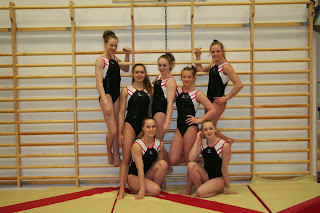For some the end of season is a dreaded time full of uncertenaties but most gymnasts and coaches look forward to this time in many respects. This should be a time looked forward to and used wisely.
After the last gymnasts last competition every gymnast is on the same page and not preparing for different obligations which can sometimes seem endless.
As we know in artistic gymnastics there never really is an off season but we should try to make the most of the different times of the year to keep up interest and make the most of the time we have in the gym.
Here are some of my ideas on how to use this time most effectively. By making it fun and
1. Gymnasts are usually in top physical shape and have mastered their "old" skills thus ready to try out some new ones. Use this everybody likes to try something new and exciting.
2. It is a great time to reflect on strengths and weaknesses to do even better next season. Start to think about the upcoming season tests, competitions etc
3. Try to communicate with every gymnast individually about their feelings on the past season and their hopes for the next one. Then talk to the group as a whole talk to them about the upcoming season and what to expect,
4. Very often new ideas for skills and physical preparation have emerged but there has been no time to try them out. This is the perfect time. Some are great and will fit into the program others are fun but of little use and others are not usable at least not in the context we are looking for in streamlining our program.
5. In this time period it is great to try out some games and competitions and measure physical abilities to better quantify next seasons program and reflect on the previous seasons strengths and weaknesses
6. Let the gymnast play with new skills and combinations. Teach them the fundamentals about the COP so they understand how best to maximize their scoring potential regardless of their ability or skill level.
7. Take a field trip to a friendly club either for a joint training or swap facilities for a day or a weekend.
8. Bring in a guest coach. In most gyms the coaches never get their full holiday due to many competition obligations and this is the perfect time to give some of the coaches well deserved time off and do something totally different for the group i.e. yoga, sprinting, dance, ballet, aerobics.
9. Swap day. for one day swap your class with somebody else. Or combine classes of different levels or even genders.
10. Christmas or spring show. After a grueling season shows involving all levels is a great idea. The benefits are greater feel of belonging to the club. Gymnasts of all ages and abilities work together for a common goal. The younger / less advantaged gymnasts get to work with the elite team and the elite team gets to perform for a much larger crowd than at the normal national / regional competition. The programs used for this can for example be used as new warm up program, basic dance training (which never seems to be time for), laying some ground work for next seasons comp. and optional routines.
If from a small / developing club get some more advanced gymnasts from the nearby gyms bring in a name gymnast from your area if possible. And don´t be shy to offer to bring an act to your local mall or charity it is a great exposure for your busyness and great for your gymnast to show off their hard work for some strangers some of whom have never even heard of gymnastics.
So don´t be afraid of thinking outside of the box. Everybody including the coach has a great need to charge his/hers batteries for the upcoming season which is as we know it just around the corner.
Use your time wisely.... Boredom can be the end of a career both for the gymnast and coach.


